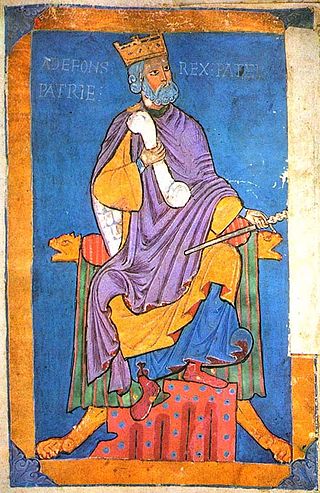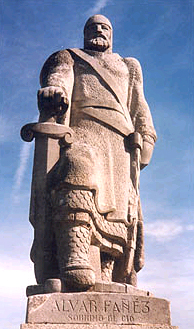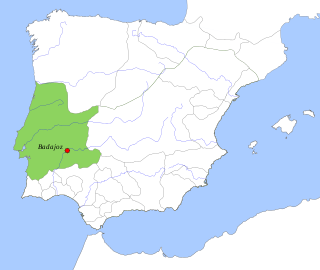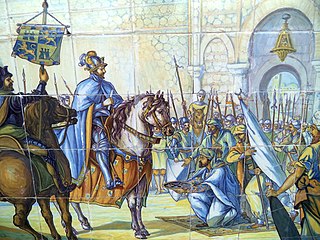Related Research Articles

Rodrigo Díaz de Vivar was a Castilian knight and warlord in medieval Spain. Fighting with both Christian and Muslim armies during his lifetime, he earned the Arabic honorific as-Sayyid, which would evolve into El Cid, and the Spanish honorific El Campeador. He was born in Vivar, a village near the city of Burgos. As the head of his loyal knights, he came to dominate the Levante of the Iberian Peninsula at the end of the 11th century. He reclaimed the Taifa of Valencia from Moorish control for a brief period during the Reconquista, ruling the principality as its Prince from 17 June 1094 until his death in 1099. His wife, Jimena Díaz, inherited the city and maintained it until 1102 when it was reconquered by the Moors.
The Abbadid dynasty or Abbadids was an Arab Muslim dynasty which ruled the Taifa of Seville in al-Andalus following the downfall of the Caliphate of Cordoba in 1031. After the collapse, they were the most powerful Taifa and before long absorbed most of the others. Abbadid rule lasted from about 1023 until 1091, but during the short period of its existence it exhibited singular energy and typified its time.

Alfonso VI, nicknamed the Brave or the Valiant, was king of León (1065–1109), Galicia (1071–1109), and Castile (1072–1109).

The taifas were the independent Muslim principalities and kingdoms of the Iberian Peninsula, referred to by Muslims as al-Andalus, that emerged from the decline and fall of the Umayyad Caliphate of Córdoba between 1009 and 1031. They were a recurring feature of al-Andalus history.

Al-Mu'tamid Muhammad ibn Abbad al-Lakhmi, also known as Abbad III, was the third and last ruler of the Taifa of Seville in Al-Andalus, as well as a renowned poet. He was the final ruler of the Arab Abbadid dynasty of Seville, before being deposed by the Almoravids in 1091.

Álvar Fáñez was a Leonese nobleman and military leader under Alfonso VI of León and Castile, becoming the nearly independent ruler of Toledo under Queen Urraca. He became the subject of legend, being transformed by the Poema de Mio Cid, Spain's national epic, into Álvar Fáñez Minaya, a loyal vassal and commander under Rodrigo Diaz de Vivar, El Cid, during the latter's exile and his conquest of Valencia.

Yusuf ibn Tashfin, also Tashafin, Teshufin, was leader of the Berber Almoravid empire. He co-founded the city of Marrakesh and led the Muslim forces in the Battle of Sagrajas. Yusuf ibn Tashfin came to Al-Andalus from the Maghreb to help the Muslims fight against Alfonso VI, eventually achieving victory in Sagrajas and promoting an Islamic system in the region. In 1061 he took the title “Amir al-Muslimeen” recognising the suzerainty of the Abbasid Caliphate. He was married to Zaynab an-Nafzawiyyah, whom he reportedly trusted politically.
This is a timeline of notable events during the period of Muslim presence in Iberia, starting with the Umayyad conquest in the 8th century.

SisnandoDavides was a Mozarab nobleman and military leader of the Reconquista, born in Tentúgal, near Coimbra. He was a contemporary and acquaintance of El Cid, but his sphere of activity was in Iberia's southwest.

The Battle of Sagrajas, also called Zalaca or Zallaqa, was a battle between the Almoravid army led by their King Yusuf ibn Tashfin and an army led by the Castilian King Alfonso VI. The Almoravids responded to the call of Jihad by the taifas which commonly fought amongst themselves however they had united to battle the powerful Christian states to the north. The Taifas aided the Almoravids during the battle with troops, favoring the battle for the Muslim side. The battleground was later called az-Zallaqah because of the poor footing caused by the tremendous amount of bloodshed that day, which gave rise to its name in Arabic.

The Taifa of Seville was an Arab kingdom which was ruled by the Abbadid dynasty. It was established in 1023 and lasted until 1091, in what is today southern Spain and Portugal. It gained independence from the Caliphate of Cordoba and it expanded the territory it ruled in the mid-11th century. The emerging power of Castile led Seville to ask military assistance from the Almoravids, who then occupied Seville.

The taifa of Zaragoza was an independent Arab Muslim state in the east of Al-Andalus, which was established in 1018 as one of the taifa kingdoms, with its capital in Saraqusta (Zaragoza) city. Zaragoza's taifa emerged in the 11th century following the destruction of the Caliphate of Córdoba in the Moorish controlled Iberian Peninsula.

The Taifa of Toledo was an islamic polity (taifa) located in the centre of the Iberian Peninsula in the high middle ages. It was ruled by the Dhulnunids, a Hawwara Berber clan. It emerged after 1018 upon the fracturing of the Caliphate of Córdoba, when the Dhulnunids, already strong in the lands of Santaver, Cuenca, Huete and Uclés, seized control over the city of Toledo, the capital of the Middle March of Al-Andalus. Upon later territorial conquest, the taifa also expanded to the land of Calatrava. It lasted until the Christian conquest of Toledo in 1085.

The Taifa of Valencia was a medieval Moorish taifa kingdom which existed, in and around Valencia, Spain during four distinct periods: from 1010 to 1065, from 1075 to 1099, from 1145 to 1147 and last from 1229 to 1238 when it was finally conquered by the Crown of Aragon.

The Taifa of Badajoz was a medieval Islamic Moorish kingdom located in what is now parts of Portugal and Spain. It was centred on the city of Badajoz which exists today as the first city of Extremadura, in Spain.
Abu Muhammad Mazdali ibn Tilankan was a Berber military commander and diplomat for the Almoravid empire. Once Yusuf ibn Tashfin decided to become independent, he chose Mazdali, his second cousin and made him one of his most effective collaborators, to subdue and pacify the Maghrib and al-Andalus.
Emperor of the Two Religions was a titled reportedly used by King Alfonso VI of León and Castile after 1085. While Alfonso used the title Emperor of All Spain from at least 1077, the evidence for the adoption of a specific title referring to Christianity and Islam after 1085 is late and scholars are divided on its reliability.
The Dhulnunid dynasty or Dhunnunid dynasty, known in Arabic sources as 'Banū Dhī al-Nūn' was a Muslim Berber dynasty that reigned over the Taifa of Toledo in Al-Andalus in the 11th century.
Abu Ahmad Jaafar bin Abdullah bin Jahhaff al-Ma’afari or Ibn Yahhaf was a judge and was the last ruler of the Taifa of Valencia before it fell to El Cid in 1094.

The siege of Toledo was Alfonso VI of León and Castile's siege and conquest of Toledo, capital of the Taifa of Toledo, from Yahya al-Qadir of the Dhulnunid dynasty in Muharram 478 / May 1085. The Castilian conquest of the former Visigothic capital was achieved through a strategy of attrition warfare developed by Castile in the preceding years. As it represented a shift in power on the Iberian peninsula, the siege of Toledo was the most significant event in the taifa period.
References
- 1 2 "Al-Qadir". dbe.rah.es. Real Academia de la Historia. Retrieved 8 April 2021.
- ↑ "La Conquista de Toledo, mayo de 1085". elretohistorico.com. El Reto Historico. Retrieved 8 April 2021.
- ↑ Schippers, A. "La bataille de Zallaqah (Sagrajas) dans la poesie d'Ibn Khafajah" (PDF). pure.uva.nl. University of Amsterdam. Retrieved 8 April 2021.
- ↑ Dunlop, D. M. (1942). "The Dhunnunids of Toledo" (PDF). The Journal of the Royal Asiatic Society of Great Britain and Ireland. 2: 77–96. Retrieved 7 April 2021.